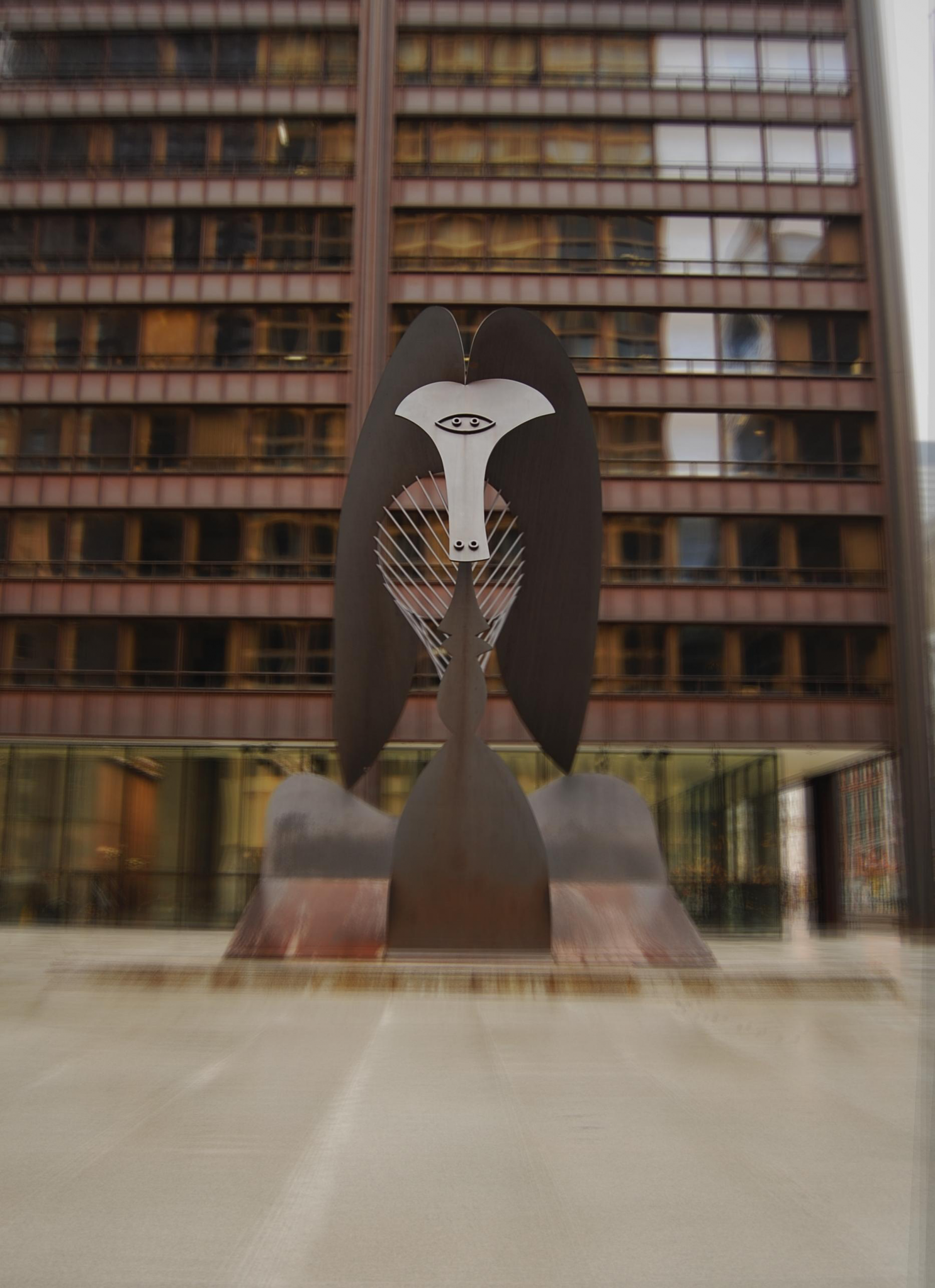
The Co-Prosperity Sphere is pretty bare. About thirty attendees sit on benches and chairs before the screen. The topic is public art in Chicago in general, and the Chicago Picasso in particular: a fifty-foot untitled sculpture in the Loop, dedicated to the city in 1967.
Some say it looks like a bird, a bug, a baboon; others see a woman. At any rate, this debate will not be settled by tonight’s features: WNET’s “The Chicago Picasso” (1967, 60min), and Tom Palazzolo’s “The Bride Stripped Bare” (1967, 12min). Picasso himself, but for his photo, appears in neither film. A quick opening speech establishes that Palazzolo, present tonight, has brought along a short third film to close the evening.
Without further ado, “The Chicago Picasso” begins. A rather serious-sounding voice is the first thing we hear: “This is a film about the difficult birth of a great work of art.” This more or less sets the tone. A few doughy talking heads cycle through, telling us that Picasso is very good at art and that his sculpture is very good. The narrative is sparse. First, Picasso made a maquette; people from the Chicago side came to him to pick it up. Then, as practice, a ten-and-a-half-foot model was constructed here in the States. Eighteen months later, work began on the big one.
Interesting, sure, but not exactly high drama. Not sixty minutes worth of high drama, at any rate—and so we see much of vehicles transporting bits of the statue, and steelworkers working on it. But this latter footage is more than mere padding: as we learn at the very end of the credits, the film is sponsored by U.S. Steel. So the documentary’s industrial feel was less than accidental.
Perhaps the most vibrant scenes come at the actual unveiling: a huge blue tarp is torn away from the great beast and the gathered citizens noticeably decline to clap. Mayor Daley looks up, confused. We will see this scene revisited in the next film.
Intermission. Palazzolo stands up to introduce his films. He’s funny, his hair is sticking up, and he seems happy to be here. He tells us that around the time he shot “The Bride Stripped Bare,” Roger Ebert often came to see his films. The raciness of the film itself was calculated: Palazzolo shot it the year before censorship was struck down, and he knew Ebert liked to see some skin.
Palazzolo seems determined to heckle his own film, and essentially provides a live commentary. The meat of the film was shot at the unveiling, but without the privileged position enjoyed by the first film. In other words, we see a lot of the crowd. We also see the cameraman himself climbing a tree—the police quickly come to relieve him of his perch.
Intercut with all this is a bevy of eclectic footage: other art, televisions, strip clubs, and, most centrally, a young nearly-nude woman wrapped in a blue tarp. She sheds it in time with the unveiling of the Picasso. As Palazzolo says with pride, he found a living Picasso for this film who can move her eyes independently of one another. They’re now married, he adds. Wedding music blares triumphantly in the background. The camera lingers.
Palazzolo’s third film, “Pets on Parade,” does not appear to relate to the first two directly, as he himself sheepishly admits afterwards. But it is probably the most arresting: a series of interviews of the happy participants in a small-town children’s parade. The characters are weird and frequently very funny. A young girl tells us about her guinea pigs; a local activist explains his organization’s turtle mascot.
And despite Palazzolo’s protestations, it’s hard not to draw a certain parallel to the Picasso films. The grim, alienating phoniness of a grand public spectacle—the self-serious attitude Palazzolo mocked in his first film—juxtaposes nicely with this smaller, more intimate version of what is essentially the same thing: citizens coming together for the sake of creativity in the name of civic pride.
In the first film, the creativity has been outsourced to the masters and the industrialists; here the people express themselves in crude and colorful floats. In the first we find stony-faced reassurances of grandeur and the stamp of corporate sponsorship; here we find, to all appearances, real joy.
After the film there is a short talk between Palazzolo and Art Institute educator Annie Morse. We get some more of Palazzolo’s personal history as a ne’er-do-well and frequent arrestee (tear-gassed and beaten by cops, on many occasions), as well as an amusing digression in which Palazzolo complains that the Harold Washington Library displaced some particularly stimulating strip clubs. At this, the distinguished crowd lets out some nervous, baffled laughter. The organizers move in to end the Q&A. Unpretentious crudeness, sanitized in the name of order. Palazzolo seems amused; he’s seen it all before.
